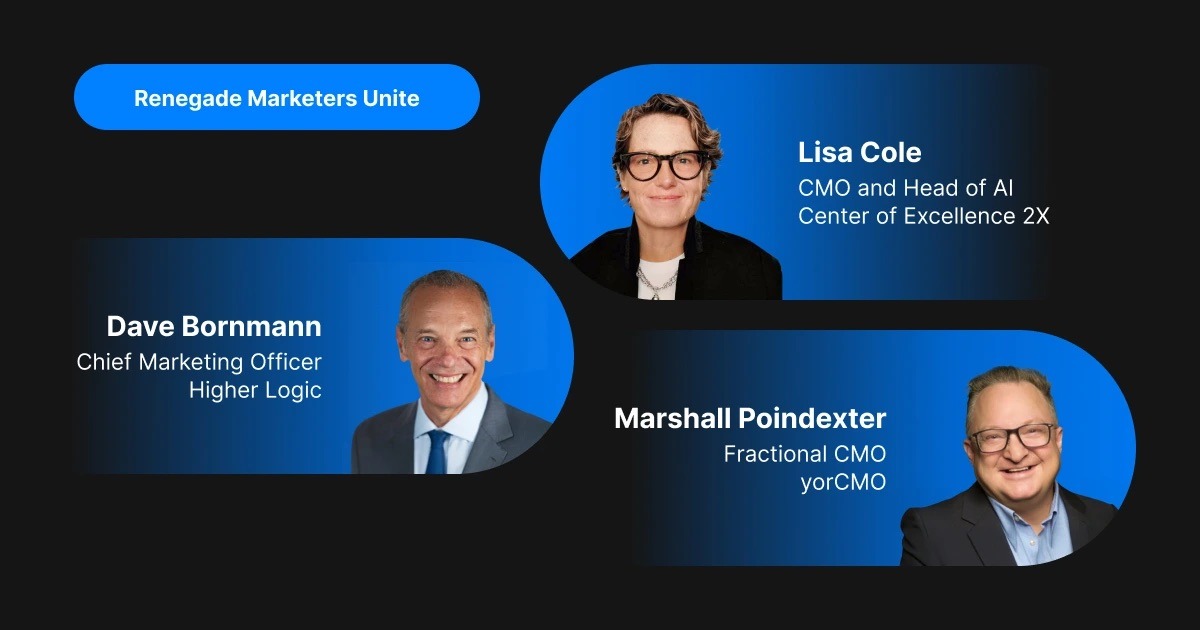January 20, 2020 | Blog
7 biggest B2B marketing trends every CMO should know (in 2020)

From intent data to martech optimization, understanding the latest industry trends will help B2B marketing leaders achieve the best outcomes from their strategies and investments in the new year. Here are seven key trends that are shaping up to be B2B marketing game changers—what they are, why they matter, and how you should leverage them properly to stay ahead of the competition.
1. Intent data
Why it matters: Data is the new oil, and B2B marketers need to know how to make the most out of their intent data—or risk losing customers to competitors.
What it is: Intent data is data that identifies prospects who are in the early stages of self-directed research to learn more about your product or solutions in your product category. By tracking a prospect’s purchase intent, businesses can achieve higher conversion rates. Intent data identifies leads that have the highest probability of buying, and sales reps can then use this information to focus their energy on the right prospects. Ultimately, it saves time, effort, and resources that would otherwise be diverted to nurturing a larger number of leads that aren’t likely to convert.
How to do it right: Success depends on speed. Although many companies have gathered a great deal of customer data, they make one mistake: waiting too long for the “perfect” data set. Intent data can provide a bird’s-eye view of the top 20 percent of leads, but it only works if you target the messaging to the relevant prospects at the right time.
Read More Intent Data: Why Speed Is the Key to Greater Sales Revenue
2. Conversational marketing
Why it matters: For most B2B firms, websites are full of lost lead-gen opportunities. One way to fix it is with a robust conversational marketing platform with tools like chatbots that can help qualify leads and guide prospects to the next step without using many sales resources.
What it is: AI-driven chatbots engage prospects when they visit a website, and are designed to help marketing teams better understand potential customers by gathering information on the problems they’re trying to solve. For some organizations, bots can reduce the response time from a few days to an instantaneous connection.
How to do it right: You get out what you put in. Creating a conversation playbook is an art that requires a combination of content, user behavior analysis, data, actionable insights, sales input, and personalized messaging delivered at the right moment. At the very least, a bot needs to satisfy key conversational components like context, personal touch, and real-time connection. But investing in the best tools will give you the means to engage prospects, gather information about them, qualify them, and connect them to the right sales rep.
3. Revenue impact marketing
Why it matters: Gone are the days when marketers could get away with just meeting their lead-gen targets. In a world of omnichannel and account-based marketing (ABM), the demands on B2B marketing leaders now include showing how every marketing dollar impacts the business. Enter the era of revenue impact marketing (RIM), which provides a much clearer picture of effort/investment vs. rewards.
What it is: Lead generation and demand creation have given way to a more ROI-driven mindset when it comes to the marketing function. RIM efforts focus on measuring the results of activities in terms of sales and revenue, so B2B marketing leaders can help produce outcomes that matter most to a business.
How to do it right: It’s all about alignment. Marketing teams that are switching to RIM should expect to work closely with sales, with the overarching goal of creating scalable and repeatable revenue outcomes.
4. ABM 2.0
Why it matters: ABM is no longer the new kid on the B2B marketing block. But progress is inevitable, and ABM 2.0 strategies can promote even higher customer engagement and shorten the sales cycle even further.
What it is: The next generation of ABM is a more customized, sales-driven approach on top of the traditional tactics. The focus remains on personalizing the experience for key accounts, but ABM 2.0 sheds the one-size-fits-all strategy and uses broader digital marketing simultaneously.
How to do it right: Growth-focused clients and enterprises each have different needs, but no matter what size the companies are, they’ll benefit from targeting accounts. What that requires is a team that not only understands the needs of the business, but also has the knowledge and know-how to design and execute a variety of demand creation strategies.
5. Martech optimization
Why it matters: B2B marketers can’t operate without digital tools, but organizations often fail to realize an expensive tool’s full potential because of a lack of expertise and resources to manage it. Optimizing the martech stack can make a difference to time- and resource-strapped CMOs—and do a great deal in changing the perception of marketing as a cost center.
What it is: Martech optimization refers to the process of ensuring the digital tools you buy provide the best ROI—and that you achieve the full potential of those tools.
How to do it right: Marketing leaders need to look at metrics like “time to value” to understand the payback of their martech investments. Another strategy is to hire an agency with staff that is appropriately skilled and better prepared to deal with the technology, since implementation and training can take time.
6. Agile marketing
Why it matters: In the digital age, marketers need to constantly solve technical problems while striving to influence customer decisions. The ability to experiment and pivot quickly toward what’s working best for business growth has become essential to success.
What it is: Agile marketing helps an organization adapt to change and focus on revenue growth, all while keeping the customer at the forefront of marketing activities. Based off a methodology that prizes iterative and continuous improvement in software development, it’s a natural direction for marketing operations to take amidst fast-changing market conditions.
How to do it right: When it comes to agile marketing, data takes center stage. Set processes and resources that will allow you to make quick, real-time decisions that will result in desired business outcomes.
Read More Why B2B Marketing Needs to Be Agile
7. Marketing as a service
Why it matters: Marketing leaders spend plenty of time innovating on the technology they use, but almost none on transforming their operating mode—despite the latter consuming more than half their budgets. But CMOs who are asked to create more impact on a flat or limited budget can do just that by leveraging a marketing-as-a-service (MaaS) agency, which provides access to the right talent at the right time, and at 30-50 percent less cost.
What it is: MaaS is a new operating model that expedites execution and iteration of demand-gen and acceleration initiatives to an external team, paving the way for marketing leaders to focus on strategic planning in-house. It involves splitting strategy from innovation work, shifting the role of internal teams, and ideally offshoring execution work to focus on standardization, scalability, efficiency, and impact.
How to do it right: Marketing leaders should leverage a MaaS agency with experience in a variety of areas to match the knowledge and skills gaps of the current team, whether it’s ABM, demand generation, analytics, or content marketing. The right agency will bring the best practices and apply them with an understanding of a CMO’s specific needs.
Read More 4 Reasons Why Leading CMOs are Adopting MaaS
The Forecast for 2020
The coming year will see forward-thinking CMOs playing it smart and lean, focusing on:
- Making the marketing function a revenue center
- Building more scalable and predictable business models with marketing as a service
- Squeezing the most out of intent data and martech investments for better business outcomes
- Developing more agile, audience-centric, and results-driven campaigns
With business impact as the goal, the most successful B2B marketing leaders must work toward becoming integrated with sales to focus on what matters most: attracting and retaining loyal customers.


